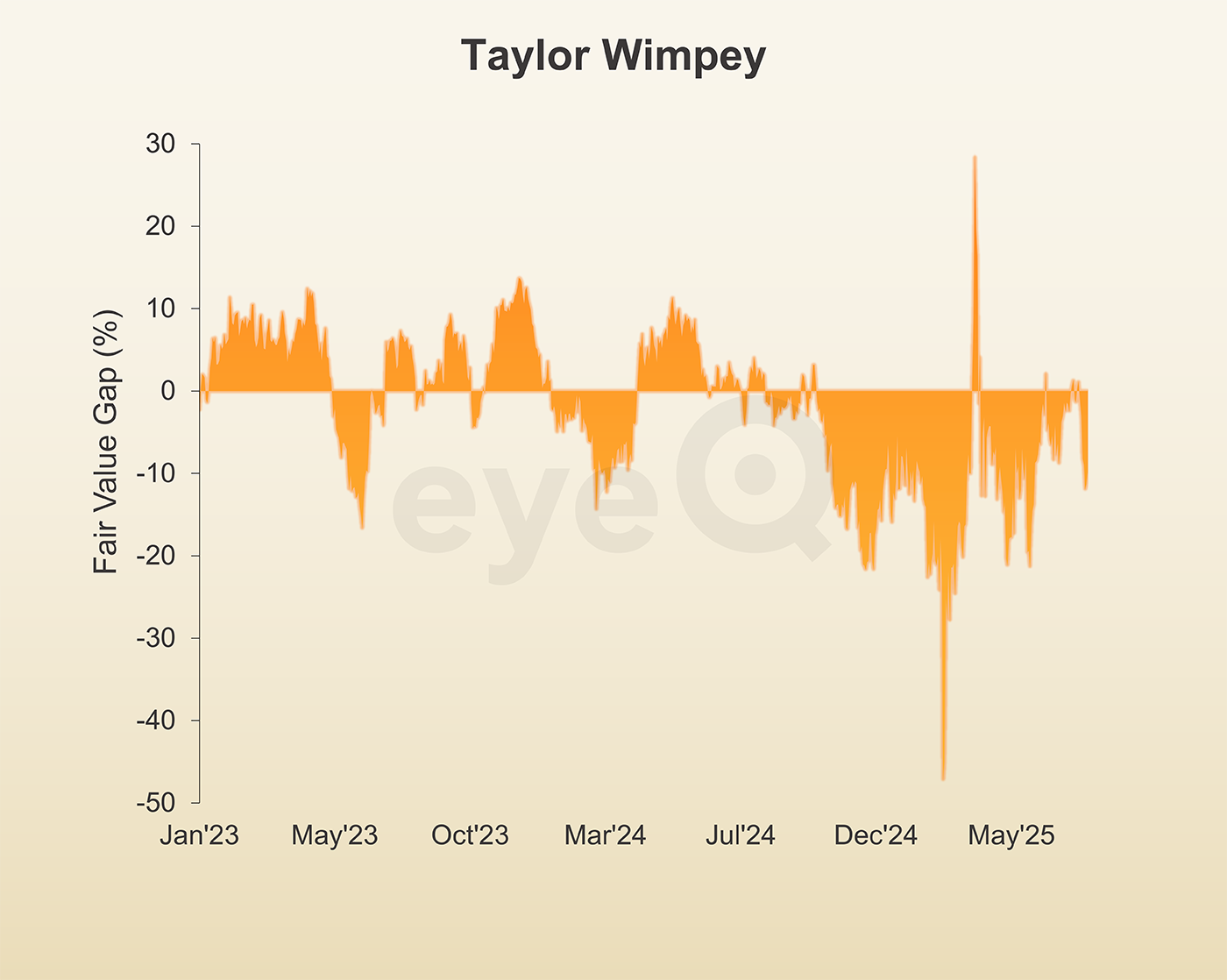eyeQ: bullish signal on this UK share
Experts at eyeQ have used AI and their own smart machine to analyse macro conditions and generate actionable trading signals. Here’s what it makes of this FTSE 100 stock.
6th August 2025 09:32
by Huw Roberts from eyeQ

“Our signals are crafted through macro-valuation, trend analysis, and meticulous back-testing. This combination ensures a comprehensive evaluation of an asset's value, market conditions, and historical performance.” eyeQ
- Discover: eyeQ analysis explained | eyeQ: our smart machine in action | Glossary
Taylor Wimpey
Macro Relevance: 71%
Model Value: 111.76p
Fair Value Gap: -9.83% discount to model value
Data correct as at 6 August 2025. Please click glossary for explanation of terms. Long-term strategic model.
Monday’s top 10 trading signals article revealed three real estate investment trusts (REITs) among the cheapest UK stocks on eyeQ’s metrics. The clear message was that, from a macro perspective, value is starting to emerge in UK property.
Today, we have a new bullish signal on the home-building giant Taylor Wimpey (LSE:TW.), which now sits almost 10% cheap to macro fair value of 112.14p.
There is an immediate health warning. Taylor Wimpey is one of those stocks where eyeQ model value has become a lot more volatile in 2025. Around Trump’s tariff announcements in April, eyeQ model value was whipped around more aggressively than the actual share price.
That’s evident in the fair value gap chart below. The extreme rich and cheap levels in March and April occurred because of sharp swings in eyeQ model value. Taylor Wimpey’s share price remained relatively stable.
That said, this latest fair value gap has developed because the opposite has been true - the share price has legged lower, but macro conditions remain stable. Looking at that fair value gap chart, this is very much the cheap end of recent ranges outside those two outlier events a few months ago around the Trump tariff shock.
It’s another example suggesting that the UK property sector has, to a fair degree, become overly pessimistic.

Source: eyeQ. Past performance is not a guide to future performance.
Useful terminology:
Model value
Where our smart machine calculates that any stock market index, single stock or exchange-traded fund (ETF) should be priced (the fair value) given the overall macroeconomic environment.
Model (macro) relevance
How confident we are in the model value. The higher the number the better! Above 65% means the macro environment is critical, so any valuation signals carry strong weight. Below 65%, we deem that something other than macro is driving the price.
Fair Value Gap (FVG)
The difference between our model value (fair value) and where the price currently is. A positive Fair Value Gap means the security is above the model value, which we refer to as “rich”. A negative FVG means that it's cheap. The bigger the FVG, the bigger the dislocation and therefore a better entry level for trades.
Long Term model
This model looks at share prices over the last 12 months, captures the company’s relationship with growth, inflation, currency shifts, central bank policy etc and calculates our key results - model value, model relevance, Fair Value Gap.
These third-party research articles are provided by eyeQ (Quant Insight). interactive investor does not make any representation as to the completeness, accuracy or timeliness of the information provided, nor do we accept any liability for any losses, costs, liabilities or expenses that may arise directly or indirectly from your use of, or reliance on, the information (except where we have acted negligently, fraudulently or in wilful default in relation to the production or distribution of the information).
The value of your investments may go down as well as up. You may not get back all the money that you invest.
Equity research is provided for information purposes only. Neither eyeQ (Quant Insight) nor interactive investor have considered your personal circumstances, and the information provided should not be considered a personal recommendation. If you are in any doubt as to the action you should take, please consult an authorised financial adviser.
Disclosure
We use a combination of fundamental and technical analysis in forming our view as to the valuation and prospects of an investment. Where relevant we have set out those particular matters we think are important in the above article, but further detail can be found here.
Please note that our article on this investment should not be considered to be a regular publication.
Details of all recommendations issued by ii during the previous 12-month period can be found here.
ii adheres to a strict code of conduct. Contributors may hold shares or have other interests in companies included in these portfolios, which could create a conflict of interests. Contributors intending to write about any financial instruments in which they have an interest are required to disclose such interest to ii and in the article itself. ii will at all times consider whether such interest impairs the objectivity of the recommendation.
In addition, individuals involved in the production of investment articles are subject to a personal account dealing restriction, which prevents them from placing a transaction in the specified instrument(s) for a period before and for five working days after such publication. This is to avoid personal interests conflicting with the interests of the recipients of those investment articles.